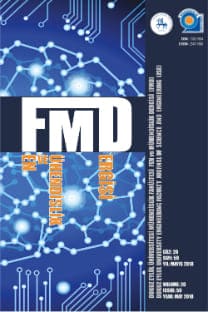Effectiveness of Steam Curing on Repairing Early Age Mortar Damages
Portland Cement Mortar, Steam Curing, Healing, Early Age Mechanical Properties.
Erken Dönem Harç Hasarlarının Tamirinde Buhar Kürünün Etkinliğinin Araştırılması
___
- Jacobsen, S., Marchand, J., Boisvert, L. 1996. Effect of Cracking and Healing on Chloride Transport in
- OPC Concrete, Cement and Concrete Research, Vol. 26, p. 869–881. Hearn, N. 1998. Self-sealing,
- Autogenous Healing and Continued Hydration: What is the Difference?, Materials and Structures, Vol. 31, p. –567. Edvardsen, C. Water Permeability Healing of Cracks in Concrete, ACI Materials Journal, Vol. 96, p. 448– Autogenous Aldea, C., Song, W., Popovics, J., Shah, S. 2000. Extent of Healing of
- Cracked Normal Strength Concrete, Journal of Materials in Civil Engineering, Vol. 12, p. 92-96. Gerard, B., Marchand, J. 2000.
- Influence of Cracking on the Diffusion Properties of Cement- Based Materials – Part I: Influence of Continuous Cracks on the Steadystate Regime, Cement and Concrete Research, Vol. 30, p. 37– Reinhardt, H.W., Jooss, M. 2003.
- Permeability and Self-Healing of Cracked Concrete as a Function of Temperature and Crack Width, Cement and Concrete Research, Vol. , p. 981–985. Granger, S., Loukili, A., Pijaudier- Cabot, G., Chanvillard, G. 2007.
- Experimental Characterization of the Self-Healing of Cracks in an Ultra Cementitious Material: Mechanical Tests and Acoustic Emission Analysis, Cement and Concrete Research, Vol. 37, p. 519–527. Alyousif, A., Lachemi, M., Yıldırım, G., Şahmaran, M. 2015. Effect of
- Self-Healing on the Different Transport Cementitious Composites, Journal of Advanced Concrete Technology, Vol. 13, p. 112-123. of Homma, D., Mihashi, H., Nishiwaki, T. 2009. Self-Healing Capability of
- Fibre Reinforced Cementitious Composites, Journal of Advanced Concrete Technology, Vol. 7, p. 217- Abdel-Jawad, Y., Haddad, R. 1992.
- Effect of Early Overloading of Concrete on Strength at Later Ages, Cement and Concrete Research, Vol. , p. 927-936. Zhong, W., Yao, W. 2008. Influence of Damage Degree on Self-Healing of Concrete, Construction and Building Materials, Vol. 22, p. –1142.
- Luo, M., Qian, C.X., Li, R.Y. 2015.
- Factors Affecting Crack Repairing Capacity of Bacteria-Based Self- Healing Concrete, Construction and Building Materials, Vol. 87, p. 1–7. Jonkers, H.M., Schlangen, E. 2008.
- Development of a Bacteria-Based Self Healing Concrete, Tailor Made Concrete Structures, London, p. 430. Jiang, Z., Li, W., Yuan, Z. 2015.
- Influence of Mineral Additives and Environmental Conditions on the Self-Healing Cementitious Materials, Cement and Concrete Composites, Vol. 57, p. –127. of Hosoda, A., Kishi, T., Arita, H., Takakuwa, Y. 2007. Self Healing of
- Crack and Water Permeability of Expansive International Conference on Self Healing Materials, Noordwijk, p. 1- st Ramezanianpour, A.M., Esmaeili, K., Ghahari, S.A., Ramezanianpour, A.A. Influence of Initial Steam Curing and Different Types of Mineral Additives on Mechanical and Durability Properties of Self- Compacting Concrete, Construction and Building Materials, Vol. 73, p. –194. Türkel, S., Alabaş, V. 2005. The Effect of Excessive Steam Curing on Portland
- Concrete, Cement and Concrete Research, Vol. 35, p. 405– 411. Ba, M.F., Qian, C.X., Guo, X.J., Han, X.Y. 2011. Effects of Steam Curing on Strength and Porous Structure of
- Water/Binder Ratio, Construction and Building Materials, Vol. 25, p. –128. Low Hilloulin, B., Hilloulin, D., Grondin, F., Loukili, A., Belie, N. 2016.
- Mechanical Regains Due to Self- Healing in Cementitious Materials: Experimental Measurements and Micro-Mechanical Model, Cement and Concrete Research, Vol. 80, p. –32.
- ISSN: 1302-9304
- Yayın Aralığı: 3
- Başlangıç: 1999
- Yayıncı: Dokuz Eylül Üniversitesi Mühendislik Fakültesi
MİKRODALGA KURUTMANIN KAOLEN NUMUNESİNİN BİLYALI DEĞİRMENDEKİ ÖZGÜL KIRILMA HIZINI ARTIRICI ETKİSİ
Selçuk SAMANLI, Özcan ÖNEY, Kamil GEVEZE
Geniş Bantlı Akım Algılayıcı için Gerekli Aktif Entegratör Devresi Tasarım ve Gerçeklemesi
Buket TURAN AZİZOĞLU, Haldun KARACA
Mg Eş-Katkılı Zn0.95Li0.05O Nanoparçacıkların Sentezi ve Karakterizasyonu
İzmir ve Çevresinin 1-B (Bir-Boyutlu) Sismik Hız Yapısının Belirlenmesi
İstanbul'un Kentsel Dönüşümü için Üretilen Binaların Deprem Güvenliklerinin Araştırılması
Ahmet AKYILDIZ TUĞRUL, KONURALP GİRGİN
Mağmatik Kayaçların Kırılganlık İndekslerinin Değerlendirilmesi
Murat YILMAZ, Selman ER, Sinem ERİŞİŞ, Atiye TUĞRUL
Mağmatik Kayaçların Kırılganlık İndekslerinin Değerlendirilmesi
MURAT YILMAZ, Selman ER, Sinem ERİŞİŞ, ATİYE TUĞRUL
ANALİTİK FONKSİYONLARIN YENİ ALT SINIFLARININ KARAKTERİSTİK ÖZELLİKLERİ
